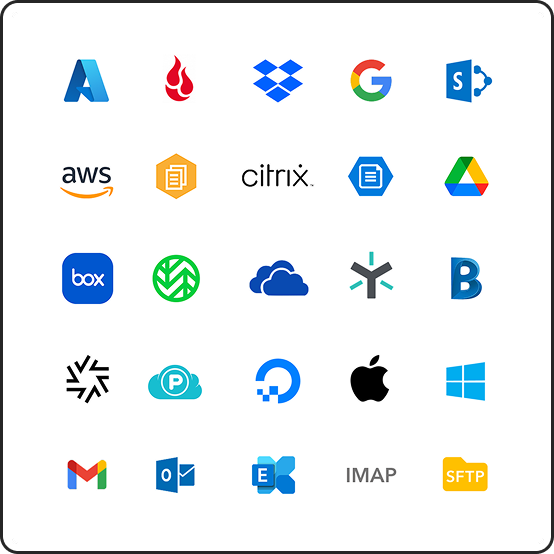Migrating data from an on-premise file server to the cloud might seem like a complicated and convoluted process because in most scenarios, IT teams are moving from an older or archaic file structure to modern tools designed for collaboration and simplicity. Add on permissions and access control and reconciling these in a different environment and it might seem like it’s not worth the trouble to move.
But Movebot makes moving from a file server to the cloud simple. By following a few best practices, you can set up your teams for success and move your on-premise file server to cloud storage and take advantage of all the benefits of working in the cloud.

On-prem to cloud migrations with Movebot
Movebot was designed to be simple and straightforward, easy enough for anyone to start moving data in minutes. Part of keeping things simple is an easy 3-step PAC migration plan. Follow this Plan, Advance, Cutover plan so you can PAC and be ready to move.
Plan
The first stage of any migration is planning. As a general rule, the more time you spend on planning, the more streamlined and efficient the migration will be. However, make sure that you know the capabilities of the tools that you are using so you don’t spend time manually doing what the tools can do for you automatically.
Taking inventory
A migration is the perfect time to take inventory and see what kind of files are on the server. While doing this you can eliminate old files and decide if any existing structures should be updated. We recommend using automated tools or scripts to take inventory instead of trying to do it manually.
With Movebot, you don’t have to move the entire file server to your destination platform. Instead, you can choose what data to move down to the folder level. Because Movebot can do this, organizations can decide which data they want to move to the cloud and if there’s anything they want to leave behind. Movebot’s filtering tools can help to isolate these files with options such as filtering by creation date, extension, and more. This means you can take the time to take stock of the data in the source, decide what needs to be moved, and how and where to move individual components.
As part of taking inventory, you should review the permissions on the on-prem file server and see if they still apply. Are certain files and folders only accessible to certain users? If so, will this same user structure be replicated for the cloud? Migrations are an ideal opportunity to review users and permissions and see if all of them are still valid. With a data migration tool like Movebot, you can take files from one user and map them to another, even moving data from multiple user profiles into a single user. Planning out this structure ahead of time can help make the new platform leaner and more efficient.
Another thing to consider is data classification. Is there any data that is more sensitive, needs greater access controls, or should only be limited to specific groups? If so, you can use these different criteria to define access controls for the cloud storage platform. Depending on which storage platform you go with, it could even change the way you store this kind of data, as some storage platforms have enhanced access and data classification features to help safeguard sensitive files from improper access.
Choosing the right cloud storage service
If you haven’t already decided where the data from the file server should go, you’ll need to research cloud storage providers and see which ones are best for your use case. Even though the major storage platforms will have the same basic functionality for storing and sharing files, they have some pretty significant differences in how they handle factors like scalability, collaboration, and integration with existing tools. Cost can be a massive difference too, especially when moving large amounts of data.
Depending on the type of data you plan to hold in cloud storage, you may need to consider compliance as well. Does the cloud storage platform meet compliance standards for the data you’ll store there? Are there any additional steps that you need to complete or costs to add to meet these requirements? Depending on the type of data and security and compliance requirements, some cloud platforms might be ill-suited for your use case.
Each cloud storage platform has a different focus. Dropbox, for example, is about collaboration, sharing, and working on the same project simultaneously. Google Workspace is an all-in-on-solution that includes workspace email, shared drives, video meeting capabilities, and more. Box emphasizes security for Enterprises, while Egnyte focuses on working with sensitive industries and integrating advances like AI for better organization. And SharePoint is excellent for staying within the Microsoft Ecosystem.
For more information on each of these platforms, see our article Which cloud storage platform is right for you?
Infrastructure and pre-migration steps
One of the most important variables in an on-prem to cloud migration is the infrastructure you use for the migration. Part of this is bandwidth planning. Insufficient bandwidth can make migrations take a painfully long time or even stall a migration completely and can be a complete project killer if not accounted for. We recommend trying to get 1Gbit or above if available, and if possible, to upgrade temporarily to the highest maximum available in your region to ensure you get the best possible speeds.
Movebot works like an advanced copy-and-paste option, meaning no files are actually moved in the process. This means that there is virtually no chance of data being lost in transit. Even still, it’s a best practice to make a backup of the data on your on-premise file server before starting the migration to the cloud.
Advance
With your files and your cloud storage provider chosen, it’s time to get moving. The Advance stage involves setting up your project in Movebot, running the migration, and checking that all files move over successfully.
One step you’ll need to do when migrating from file servers is to download and run the Movebot Agent on the server. You’ll be guided on how to do this when setting up a project when you choose Windows/OSX Agent. This will generate a unique token that you’ll need to use later on; keep note of it because it can only be revealed once and if you lose it you’ll need to make a new connection. Run the Agent on the server, which allows Movebot to connect to it and any NAS devices and move these files to the cloud.
Data preprocessing
Cleaning up and organizing the data on the on-prem server before the migration will make it easier to move and help keep the destination cleaner at the same time. Remove duplicates and outdated files, and organize content based on your migration plan.
Movebot can help with a lot of this data cleanup and do it as part of the migration if you leave the default settings enabled. Deduplication adds a prefix to files that would have the same name in the same location. Filename sanitization removes characters that aren’t allowed on the storage platform, and while this is unlikely to be an issue when coming from an on-prem server, you can use filename transformation rules to update groups of filenames with new characters to better fit how you want to present the data in the destination.
Run a test migration
Before running the main migration, we highly recommend running a few tests using the file server and your chosen destination platform to get a feel for how the migration will go. Try to make these tests as similar to the real thing as possible; for instance, if you’re planning to move across permissions make sure to test permission moving, and if you want to use automatic deduplication make sure you have some files that this will apply to so you can see how they end up in practice.
Movebot gives you a few options for running test migrations. Because large migrations can be broken down to the folder level, you could try moving a specific folder and see how it behaves. You can also simulate how a large-scale project will behave by running a Discovery scan. The scan will analyze your file server and the cloud storage environment and search for incompatibilities between the two. It will then generate a report letting you know about any updates to files Movebot will make based on your chosen settings, and if there is anything you need to address to make sure the files will move across successfully.
Migrate from on-prem to the cloud
If the tests have good results, it’s time to run the main migration. Set up your main project, choose your settings, and use filter rules to make sure to move the data you chose in the planning stage. From there, you can split the project up into as many smaller transfers as you want instead of having to do one massive move of everything on the server at once. This lets you choose which data is most important and gives you more control over your move so you can quickly move important files and make sure they arrive successfully and as expected.
Whenever a migration is running, it’s essential to keep the Movebot Agent open on the file server. Closing it will stop any ongoing migrations as it’s required to be open in order to access files on the server.
While a transfer is active in Movebot, the Performance Tracker becomes active, which gives live stats about your ongoing project. Here you’ll see metrics like the amount of data moved, the number of files transferred, and much more. It’s normal to have some ups and downs as part of the project, but if it stalls completely or you’re concerned about the metrics, you can reach out to the Support team and someone will take a look at your project.

Cutover
After finishing the bulk migration, the Cutover stage is for checking that all the files moved successfully and for running delta migrations to bring across any that didn’t.
Delta migrations
In Movebot, delta migrations are migrations that only move files that don’t exist at the destination. This can be either because they were added after the migration started or have a more recent modtime. Instead of having to move everything on the file server again, these files will be isolated and pulled across on their own transfer.
Depending on how much data you have on the file server, you may need to run multiple delta migrations. One benefit of Movebot is that these delta migrations mean that users never have to stop working on the server. Since files are copied, and delta migrations only move new and changed files, users can keep working as usual and you can run delta migrations until final changeover without having to slow normal operations.
Testing data at the destination
With all the files on your cloud storage platform, you’ll want to rigorously test the migrated data for data integrity, permissions, and accessibility. Check that the right people have the right access, and that file names and contents are as you expect.
Change management and user access settings
When users are actively working on the file server, it’s important to communicate with users and let them know about how they will work in the new storage platform. Again, giving more time here will allow users to get used to operating in the new storage platform, which will make the transition easier.
Coming from an on-prem file server also has different access settings, and each cloud storage platform handles this differently. Google Workspace, for instance, has admins set up user accounts, shared drives, and access levels in the Admin console. SharePoint/OneDrive use the Microsoft 365 portal to provision user accounts, and you’ll also need to configure SharePoint sites and OneDrive settings, as well as use Active Directory synchronization if applicable. Each platform has a different method of managing users and providing access and will have detailed instructions in their onboarding or documentation.
Data cleanup
Once the migration is complete and you’ve checked that you have all the data in the cloud storage platform, you can then delete the data on the file server. We recommend waiting a minimum of 30 days or one standard business cycle (if this is greater than 30 days) before deleting any data on the file server just in case.
Fast, simple, and reliable on prem to cloud migrations with Movebot
Migration projects tend to be big, but they don’t have to be difficult or time-consuming. Movebot makes migrating from file servers to the cloud easy thanks to the Movebot agent and zero infrastructure to set up, manage, or maintain. Move files quickly and easily by letting Movebot handle the difficult parts for you.
Try Movebot for yourself with 250GB free and no credit card required. Simply sign up for a free trial and you can start moving in minutes, with no complicated setup, onboarding call, none of that. Get started now by registering for your free trial.







